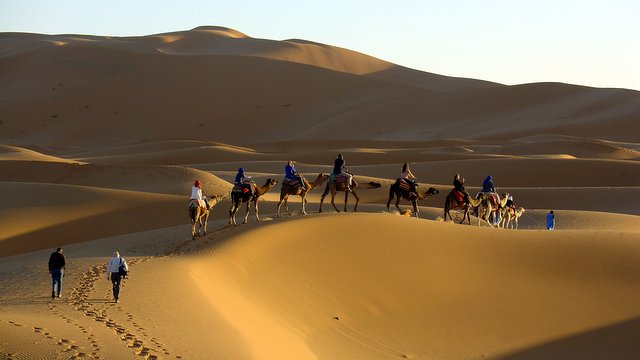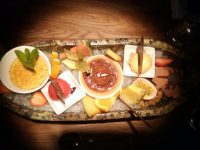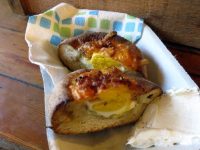
Heading into the Sahara in Morocco
This was a great two week organised trip to Morocco, flying into Casablanca and working our way round Rabat and Meknes to the derelict roman city of Volubilis then Fes.
Fes is the artisan capital of Morocco and home to the famed dyeing pits where freshly removed animal skins are processed all the way to supple and brightly coloured leather.
On arrival at the Tanneries you’re initially handed a spring of mint, without explanation. As you climbing up to a flat roof adjacent to pits its use becomes apparent – the stench from below could be overwhelming. In the distance you can see the skin arriving and being thrown into the white coloured lime filled vats. The lime still derives from the traditional pigeon droppings and cow urine, hence the acrid smell. A few days soaking removes any last hairs or scraps of flesh before they’re removed to dry out in the sun.The next stage in the process is the dyeing. The colours are made from different plants and minerals, so colour greatly affects the price, with red being the most common. Once dried again the leathers are shaped and stitched into goods, ‘all available at a discount to you good visitors in the shop just over here’.
The high vantage point also gives a terrific view over the city and the mixture of arcane processes below and progress farther afield indicated by satellite dishes and mobile phone masts.
Leaving the towns behind we headed into the desert in 4WDs then camels to spend time with the nomadic Berbers. Camping out under the stars without a tent was wonderful – zero ambient light or atmospheric pollution produced a perfect view of the night sky and we sat and talked and drank until it was time to turn in. The temperature started to drop under the cloudless sky so we all snuggled under our thin blankets and felt at one with the world. A few minutes later the silence was broken by the Nokia ringtone and one of the Berbers shouting something which probably translated as “I’m in the desert – – – No it’s rubbish!”
From the overnight stay we moved to the Todra Gorge area for an enjoyable couple of days hiking, then into the mountains and the unwittingly famous Ait Benhaddou, which even if you haven’t heard has formed the backdrop in a number of major films, from Lawrence of Arabia, to The Jewel of the Nile, Living Daylights, The Mummy and Gladiator. We spent the morning climbing over this town sited on a moderately sized hill, then continued our progress towards Essaouira.
Essaouira is built on the edge of a fishing harbour and has a particularly relaxed feel. Boats drop off their catch direct to the doors of the restaurants who then serve it simply char grilled with a squeeze of lemon.
Dating from prehistoric settlement, Essaouira has more recently been a holiday home to such people as Orson Welles, Winston Churchill, Jimi Hendrix and The Who. For some reason I just wasn’t relaxed there and ended up just sitting by the beach watch the locals play particularly skilful football on the sandy surface.
The rest of the trip was spent in Marrakech. Our hotel was almost underneath the Koutoubia Mosque, so a lie-in was out of the question once the 5.30am call to prayer started. Stumbling bleary eyed into the near empty Djemaa el Fna square on the edge of the souk we started at one of the many orange juice sellers and worked our way cautiously past the performing apes, cobras, clowns and scorpions and into the souk for some souvenir shopping.
It wasn’t until the evening when the square really came alive – it filled with dozens of food stalls selling everything from fresh fish to boiled heads with a side of tripe. After eating in the square we moved up onto a balcony and watched the people scurrying amidst the gouts of flame.







